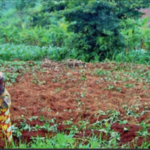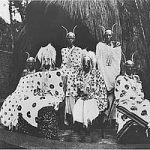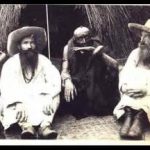III. Settlement Patterns Of The Community Of Remera
Before speaking of the community of Remera, it would be proper to define the word community as it is to be understood in this text. The term would exclude, of course, the definition of the ecologists, which includes the balance struck in the existence together of plants and bacteria and perhaps human beings; the definition would be narrower. The community is the smallest politico-social group composed of families and other institutionalized units winch, through close association form a system of relationships that is integral, or nearly so, and independent, or nearly so. The use of the word “families” excludes the need to add superfluous elements such as “two sexes,” and “three generations,” which are often added to exclude monasteries and some such establishments.
Incidentally, there is no attempt has been made to represent Remera as a “typical” community or as a sample microcosm of Ruanda society, although we know of no characteristics winch made it particularly distinctive in the region of winch it is a part. Eastern Ruanda as a whole, however, certainly has its differences from Central Ruanda. Remera has been described as a community including among its characteristics the fact that it is part of a greater society.
The distribution of household compounds on Remera is not highly concentrated. On the contrary, as everywhere in Ruanda, they are widely distributed over the Hill. The typical household compound consists of one or two huts used as habitations and a granary. The native term rugorefers tothe compound itself, but may apply also to the household as a functioning unit, or to both at the same time. Sometimes it also includes a stable or an old house used as a beer-making shed. The whole is surrounded by an enclosure made of a growing hedge. The rugo is built in the midst of the fields of the occupant and, therefore, there is normally a few hundred feet distance between a man and his neighbor’s house. If the neighbor is a brother or a son, who would have common and/or contiguous fields, the distance is usually less.
Upon closer inspection of the community map, certain clusters of compounds can be detected. These are largely determined by topography, although not altogether. For example, the large stretch of uninhabited space between the summit and the marsh land settlement is occupied by infertile posture lands. Otherwise, there is no apparent difference between settlements at the top or at the bottom of the slopes. No house is ever built on the bottom flats of the valleys.
The typical productive household generally consists of a nuclear family, that is, father, mother, and their offspring. Often, however, the children may include some of the father’s brothers’ children. There are other variants such as the children of a daughter or of a sister of the household head for whom the bride price has not been paid.
Sometimes, a man may have his mother or his grandmother —i.e., father’s mother or father’s brother’s mother — living with his household, or even his wife’s mother. The mother would usually have her own hut within his compound or nearby, as would the household head’s grown but unmarried sons. A married man may also have unmarried “brothers” and “sisters” in his household.
A typical household of which an adult woman is the head consists of a widow and her children, or a widow and one or two children “given” to her by a relative for aid and companionship. Alternatively, she may live entirely alone. Many of the older widows of Remera are actually at least half-dependent on someone else, but others are, in fact, entirely on their own.
One household of which a woman is the head consists of that woman, two grown unmarried sons, their divorced sister, and her child. Another — a rather striking one — is made up of an elderly upper-class Tutsi woman presiding over several young Tutsi women who were all divorcees.
The households headed by old men, generally speaking, do not differ much from the typical productive household. Old men most often have had several wives, the latest much younger than themselves. They are usually women who have left their original husbands and sought others. They have borne children who “belong” to these old men and constitute practically a second generation of children for them at a time when their older children have already married and perhaps even died. However, there are the odd old couples who form households by themselves, but are mostly supported by sons or neighbors who cultivate fields for them. There is also one lone old man who is the community “doctor” and who lives by means of his fees.
The basis for a population census of Remera was the official population register, a sort of index of cards, called fiches,kept on record at the chieftain’s house. These records furnish an excellent working basis, but they are incomplete and often incorrect. These, therefore, are supplemented by direct observation and the researcher’s personal enquiries of the inhabitants of Remera.
The administration’s basis for compiling the fiches had been taxation, but other criteria, also, were taken into consideration, none of which reflects a true picture of the population per household. The original 385 fiches are made up of heads of households; youths who are still part of their father’s household — or, in a few cases, form one household with their widowed mother — but who are old enough to be taxed; second wives;non-taxable widows who head households and, finally old men who have reached an age when they, theoretically, become dependents and therefore are retired from the tax roll. This last category is the least consistent, as some old men are still on the tax roster, while relatively young ones are not included on it.
On each fiche are inscribed the persons who are dependent upon the person represented by the fiche. A household head,for instance, may have on his fiche: his main wife, his unmarried daughters and his sons who are not yet on the fax roll — therefore having no fiches of their own — and whatever other dependents are living as part of his household. These dependents do not necessarily live in the same house and they can be old parents, or young children of brothers, or other relatives, etc. In fine, everyone is theoretically accounted for.
In order to present a truer picture of the household population of Remera certain modifications were effected. The widows were left as separate households even if they were alone in their household. On the other hand, the youths and the second wives were relegated to the households to which they belong, i.e., the youths, with their father’s or widowed mother’s household, and the second wives, with their husbands. (The author has done likewise with the following special cases: a young divorcee and her child who form a household with her mother and her brothers; an old man-servant to the largest Tutsi household headed by a woman, as well as another divorcee who is part of this latter household. These persons were included in the household in which they reside.) There are also four young men of the Hill whose whereabouts have not been determined; they were not counted at all. Many individuals are in Uganda, some of whom had been gone for several years and hope of seeing them again is lost. These men were also not counted after a period of five year’s absence, even when their names have remained in the fiches, except for one man who has been absent seven years, but who is still expected back. A few others have been away for less than five years, but they were not counted in because they went with the intention of not returning to Remera.
The original 385 fiches were further reduced in number by the removal of four households which, although registered in Remera, properly belong to a paysannat situated within the jurisdiction of Remera, but which is definitely not part of the Remera community. (The paysannat project in the Congo and Ruanda-Urundi represented an effort on the part of Belgian administration to gather the natives into some sort of villagecommunity with plotted fields cultivated under the direct supervision of the Agricultural Service. The natives were free to join or not.) Also removed from the census is a widow and her taxable son and their household who live within the territory of an adjacent Hill.
On the other hand, three complete households, for which the necessary information was gathered, were added to the fiches. A certain number of individuals were also added to various households to which they belong, but with which they had not been recorded. Finally, the composition of the households was calculated as per the day of the beginning of the author’s investigation on Remera.
The modal Tutsi household contains five or six members. Among the Hutu, the most frequent households are those having three members; frequency goes down regularly to the maximum size of thirteen persons,except for a surprising dearth of four-person households. The same relative lack of households of this size is to be noted among the Tutsi.
The overall deficiency in four-person households seems to be due in large part to the fact that other types of households drop off at four members, probably for economic reasons.
By “efficient”, is meant that the households are headed by men approximately between the ages of twenty and forty-five, who are the main producers, reproducers, and the active participants in Hill affairs.
The women’s households, however, show a higher proportion of persons living alone.
The old men’s households, on the other hand, show a distinctive pattern, involving a clearly binodal distribution. The old men have a high frequency of households of two and three persons. Frequency decreases markedly for households of four after which it increases to reach another peak of households of six persons, and then drops off. This binodality is probably explained by the fact that there are two kinds of old men’s households. The first are those composed of men who live quietly, “in retirement”, with their old wives and perhaps a child “lent” to them by a relative. The other kind is that of men who, although they may be old enough to be tax-exempt, are still active in community affairs have young wives and several young children, some of whom are strong enough to help in the fields.
The presence of part of this transient population is normal, but another part is a direct result of the situation of unrest in the country. The normal transient population consists of various relatives and friends who come to visit for a few days at a time. There is also a steady stream of courtiers and other “courtesy” visitorsthat come to the chieftain’s house. (This declined, however, after the election of the new burgomaster who eventually forbade such visits to the ex-chieftain’s house.)
The extraordinary transient population was composed exclusively of Tutsi from Central Ruanda, who, because of political pressure of one sort or another, had to flee their homes in Central Ruanda and were taken into the houses of Tutsi in the Territory of Kibungu. Remera had its share of these refugees. One resident of the Hill had twelve refugees for several months; another had four. The ex-chieftain always had several, in varying numbers, during the crisis. One Tutsi lady who headed a household of women, took in refugee girls one at a time, changing each week. One progressive young man from Kigali, who had contracted to build the new schoolhouse at Remera, decided to take up residence and brought his whole family to Remera. This Tutsi influx occurred during the months of September, October, and November 1960, after which it diminished.
By rough estimate, the area of Remera is perhaps twelve square miles, which gives a density of 126.6 persons per square mile. This is surprisingly low when one compares it with the figure given by Monsieur Gourou for the sub-chiefdom of Remera, which is 67.6 persons per square kilometer, or 175 per square mile. It should be noted that M. Gourou calculated his estimate on the basis of “usable surface”. He may, therefore, have excluded some land; the inclusion of winch would lower his density to a figure comparable to 126.6.
Many of the inhabitants of Remera are originally from elsewhere. The Tutsi and Hutu are mobile for different reasons. Tutsi have generally moved about with the fortunes of their lords’ political success; they are often councilors of the chieftain or his relatives. The Tutsi “contiguous fathers” were classified as such only because their place of residence was neighboring Bisenga when their Remera sons were born.
In fact, they would more properly fit under the “far” category since these fathers were born in Central Ruanda, or some distant place, from which they moved to Bisenga:
The Hutu, by contrast, have usually moved from nearby Hills, because they were not satisfied with their lot under a particular chieftain. As a result, they changed allegiance by settling into a neighboringterritory, which they knew and considered preferable.
https://uk.amateka.net/iii-settlement-patterns-of-the-community-of-remera/https://uk.amateka.net/wp-content/uploads/2021/03/community.pnghttps://uk.amateka.net/wp-content/uploads/2021/03/community-150x150.pngModel CitizenshipBefore speaking of the community of Remera, it would be proper to define the word community as it is to be understood in this text. The term would exclude, of course, the definition of the ecologists, which includes the balance struck in the existence together of plants and bacteria...BarataBarata rpierre@ikaze.netAdministratorAMATEKA | HISTORY OF RWANDA




